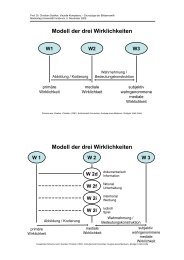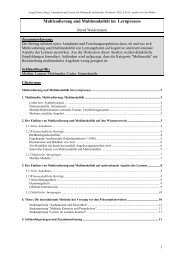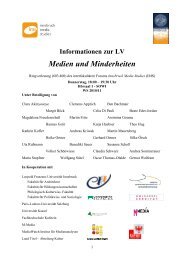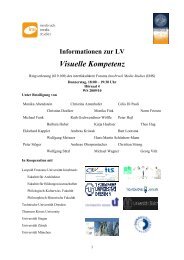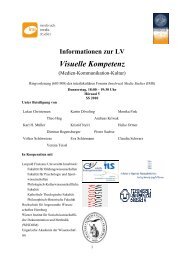Kinder und Medien - BiwiWiki
Kinder und Medien - BiwiWiki
Kinder und Medien - BiwiWiki
Erfolgreiche ePaper selbst erstellen
Machen Sie aus Ihren PDF Publikationen ein blätterbares Flipbook mit unserer einzigartigen Google optimierten e-Paper Software.
WS 08/09: Ringvorlesung <strong>Kinder</strong> <strong>und</strong> <strong>Medien</strong> (LV-Nr. 603.696)<br />
including that exposed within search engines such as Google and Yahoo!, has still room for<br />
improvement. Annotating media with machine-processable descriptive information is seen as a<br />
promising approach towards the alleviation of this situation. In this lecture we will give an overview<br />
of the Semantic Web idea, introduce the basic principles behind semantic technologies, and explain<br />
how they can be applied to enhance traditional media retrieval. The creation of semantic descriptions<br />
of media resources is a central component thereof. We will present different methods and tools,<br />
notably games with a purpose, which allow novice users to easily create such semantic descriptions in<br />
an entertaining and motivating manner. The resulting machine-processable information forms the basis<br />
for the development of novel media retrieval techniques which in many aspects advance the state of<br />
the art in the field.<br />
Zur Person<br />
Dr. in Elena Simperl works as a senior researcher and vice-director of the Semantic Technology<br />
Institute (STI Innsbruck, www.sti-innsbruck.at) at the University of Innsbruck. She obtained a PhD in<br />
Computer Science (Dr.rer.nat) from the Free University of Berlin in February 2007 after graduating<br />
with a Computer Science diploma at the Technical University of Munich. Elena Simperl has been<br />
involved in several research projects with a Semantic Web focus at European level. In particular she is<br />
interested in application- and business-oriented aspects of ontology building and management, as well<br />
as in collaborative approaches to semantic applications. She currently approaches these topics in<br />
research projects such as the EU-f<strong>und</strong>ed initiatives TripCom, Salero, LarKC, ACTIVE and Service<br />
Web 3.0. She is moreover scientific coordinator of the EU-STREP project TripCom and the EU-SA<br />
Service Web 3.0, and was project manager of the EU Network of Excellence Knowledge Web.<br />
Zur Person<br />
Mag. a Katharina Siorpaes is a researcher at the Semantic Technology Institute (STI Innsbruck,<br />
www.sti-innsbruck.at) at the University of Innsbruck. She holds a master of Computer Science from<br />
the University of Innsbruck and has been working at the Semantic Technology Institute (formerly<br />
known as DERI) since 2004. She is contributing to the national project myOntology<br />
(www.myontology.org) and the EU project ACTIVE (www.active-project.eu). Her main research<br />
interests are community-gro<strong>und</strong>ed evolution of structured knowledge, especially ontologies and<br />
incentives for the Semantic Web. More specifically, in OntoGame (www.ontogame.org) Katharina<br />
Siorpaes is working on modeling semantic content authoring tasks as online, multi-player games in<br />
order to create proper incentives for humans to contribute.<br />
Moderation: Andreas Kriwak<br />
6. Eva Binder & Sylvia Hölzl: Sojuzdetfil’m – <strong>Kinder</strong>film im Staatsauftrag<br />
(13. Nov. 08, HS 4)<br />
Abstract<br />
Im Jahr 1936 wurde in Moskau das <strong>Kinder</strong>filmstudio „Sojuzdetfil’m“ gegründet. Die zwei<br />
wesentlichen <strong>Kinder</strong>filmgenres, die dort in den Jahren bis zum Zweiten Weltkrieg entwickelt bzw.<br />
weiterentwickelt wurden, waren Abenteuerfilme mit Revolutionsthematik sowie Märchenfilme.<br />
Während die Hauptfiguren in Märchenfilmen meist Erwachsene sind, treten in den Abenteuerfilmen<br />
<strong>Kinder</strong>darsteller auf, die als starke Identifikationsfiguren angelegt sind <strong>und</strong> im Sinne der<br />
Sowjetideologie einen Erziehungsauftrag erfüllen sollten. Anhand der beiden Filme Beleet parus<br />
odinokij (1936; nach dem gleichnamigen Roman von Valentin Kataev) sowie Timur i ego kommanda<br />
(1940; nach der gleichnamigen Erzählung von Arkadij Gajdar) sollen Fragen nach den<br />
Genrekonventionen sowie nach den kindlichen Identifikationsfiguren im Vergleich mit den<br />
literarischen Vorlagen erörtert werden.<br />
Zur Person<br />
Dr. in Eva Binder ist als wissenschaftliche Mitarbeiterin am Institut für Slawistik der Universität<br />
Innsbruck tätig. Nach ihrem Studium der Slawistik <strong>und</strong> Anglistik nahm sie ihre Tätigkeit in zwei<br />
Forschungsprojekten auf, die sich mit dem russischen <strong>und</strong> sowjetischen Filmschaffen im Kontext der<br />
russischen Kultur befassten. Seither entstanden zahlreiche Publikationen zu diesem Bereich; u.a.<br />
bearbeitete sie in der Geschichte des sowjetischen <strong>und</strong> russischen Films (Metzler 1999) die achtziger<br />
<strong>und</strong> neunziger Jahre, ist Mitherausgeberin des Bandes Eisensteins Erben. Der sowjetische Film vom<br />
9




